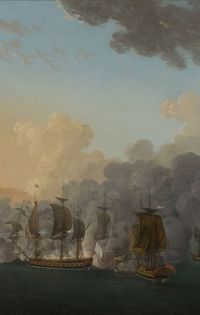Battle of Louisbourg, 21 July 1781
Rochefort / Rochefort - Hôtel de Cheusses/Arsenal
Commissioned by King Louis XVI, Rossel’s works are the only French paintings from the late 18th century depicting the naval battles fought to achieve America’s independence.
Paintings for the King
 Enlarge image : Combat de Louisbourg
Enlarge image : Combat de Louisbourg
In 1786, Louis XVI commissioned Auguste Louis de Rossel (1736-1804) to produce a series of 18 paintings depicting the French Navy’s main sea victories during the American War of Independence (1775-1783). Rossel enrolled at the Naval Guards’ School in Rochefort in 1751, spent a long career in the Navy and took part in numerous campaigns. As the commission was addressed to a former naval officer, it was above all intended to bear witness to the sea battles in question and provide an ideal image of France’s role in the war.
“A true national monument”
Although the paintings did not end up at their initial destination, they were originally painted to adorn navy cadets’ classrooms in Rochefort, Brest and Toulon. Two copies of each painting were produced, one for the Minister of the Navy and the other for the French officer who had won the battle depicted. In the space of four years, Rossel produced 16 original paintings and 33 copies. In 1790, the French Parliament hailed the series as a “true national monument”. Remarkably enough, these works are the only French paintings from the late 18th century depicting the naval battles fought to achieve America’s independence.
The Battle of Louisbourg
One of Rossel’s paintings depicts the Battle of Louisbourg, fought between the French and English fleets off America’s northeast coast on 21 July 1781. Commanded by Lapérouse, the French frigates L’Hermione and L’Astrée confronted five English ships, which managed to escape during the night. The two frigates are depicted side-on in the painting’s foreground. L'Hermione, which is only known to have been depicted in this painting and its copies, is on the left.
Rossel merged two points in the battle into a single scene: the battle itself and the capture of one of the English frigates. In the centre of the composition, the English ship has struck its flag and its commander is in a longboat, on his way to surrender to Lapérouse. Basing himself on historical fact, the painter provided an idealised patriotic vision of the French Navy, depicting the English surrender and French victory.
Collection highlight
The essential works to see during your visit to the Musée national de la Marine in Brest, Port-Louis, Rochefort, Toulon, and soon in Paris.




